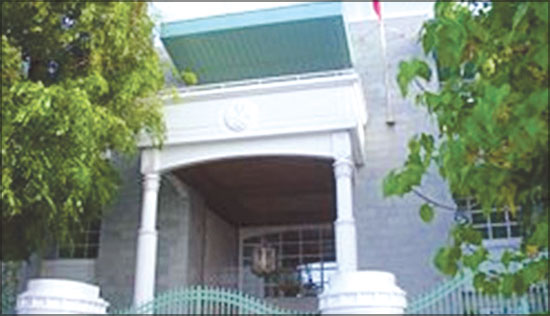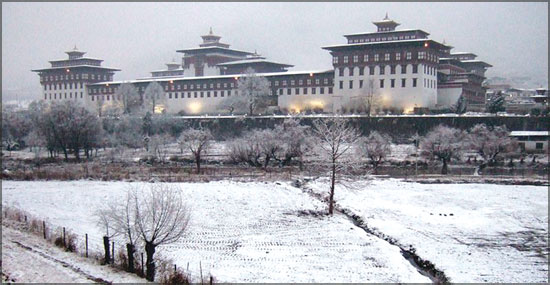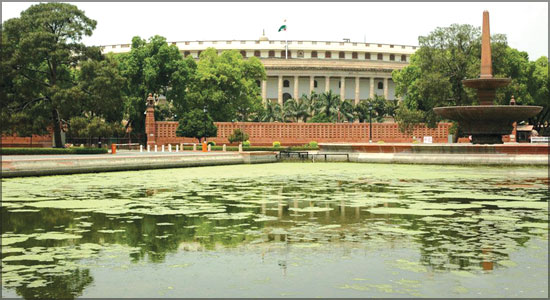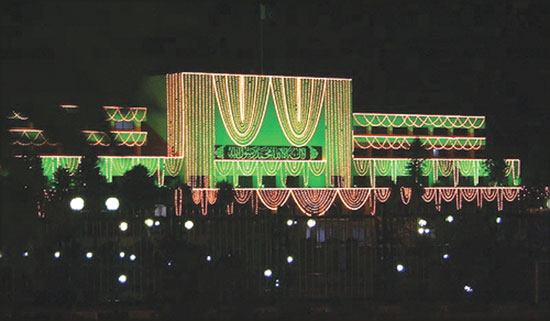SAARC member countries in a nutshell
Afghanistan
Afghanistan is a mountainous landlocked country, located in Central
Asia. Afghanistan achieved a matter of national unity in 1747 and became
a Constitutional Monarchy in 1931. The modern history of Afghanistan
started when it got independence from the United Kingdom in 8 August
1919.
|

Apartment complex in Kabul |
In 1973 the Monarchy was overthrown in a bloodless coup, and a
republic was established. The republic failed to survive and in late
December of 1979 thousands of soviet troops were air lifted into the
country. The war against the Soviets lasted many years, before the
ceasefire just a few years ago.
All the citizens of the country are called Afghans. The staple food
of the villagers and town's people is bread and rice. Among other basic
foods are cheese, chicken, lamb, eggs, onions, spiced tea, melons,
cucumbers, and other fruit.
Large amounts of meat, rice, and vegetables are consumed by the
Afghans. Rice is often served with meat, herbs, and sauces. Other
popular items include filled and fried pastries as well as
rose-water-flavored drinks.
For centuries, Afghanistan has been a mosaic of people with diverse
cultures, religions and languages. Afghanistan's ethnically and
linguistically rich and mixed population reflects its location at the
crossroads of Central, South and Southwest Asia. Communities with
separate religions, languages, and ethnic backgrounds have lived side by
side for generations.
|

Presidential Office in Malé |
Afghanistan still remains a country of dynamic diversity. The main
ethnic groups are Pashtun, Tajik, Hazara, Uzbek, Turkmen, Aimaq, Baluch,
Nuristani, and Kizilbash.
Afghanistan is an Islamic country. An estimated 80% of the population
is Sunni, following the Hanafi School of jurisprudence. The remainder of
the population is predominantly Shi'a. Pashto and Dari are Afghanistan's
official languages. Afghanistan's Consitution stipulates that all other
languages are "official" in the areas in which they are spoken by a
majority of the population.
Dari is spoken by more than one-third of the population and Pashto is
spoken throughout Kabul and eastern and southern Afghanistan. Many
Afghans are multi-lingual. Tajik and Turkic languages are spoken widely
in the north. Smaller groups throughout the country also speak more than
70 other languages and numerous dialects.
Maldives
The civilizations of Maldives as far as can be estimated, dates back
more than 2000 years. Archeological findings from many ancient sites in
Maldives show ruins of old Buddhist structures, some dating back to 3rd
and 4th centuries. The evidence shows that at the time of conversion to
Islam in 1153 A.D. the population of Maldives was mainly Buddhist.
|

Bhutan Parliament in winter |
Throughout its history, Maldives has remained independent, although
the Portuguese occupied the country for 15 years in the 16th century.
From 1887, Maldives was a British protectorate until it became fully
independent on 26 July 1965.
The archipelago of the Republic of Maldives is made up of a chain of
1190 small and low-lying islands, stretching over 800 kms from north to
south. Out of them only 198 islands are inhabited.
The population of Maldives is 270,101 (2000 census). Maldivians
comprise a mixed race, unified through sharing a common history,
language and religion. Dhivehi is the official language. Islam is the
strength and backbone of the country, permeating the entire fabric of
the Maldivian culture, polity and civil society.
The Maldives political system is a unique blend of its history,
traditions, Islamic faith and modern democratic principles. It has
evolved over a period of many years, the first written constitution
having been proclaimed in 1932, though unwritten constitutional
principles had been in existence long before then.
A republican form of government in 1968 replaced the constitutional
monarchy, with an Executive President as the Head of State. A new
Constitution, that is more comprehensive and in tune with the country's
democratic principles was adopted by the country on 1 January 1998.
|

Parliament of India |
The mainstay of the Maldives economy today comprises fisheries and
tourism. Nearly 19% of the labour force is engaged in the fisheries
sector, which account for over 6% of the GDP. Tourism, which became a
major industry since the mid-eighties accounts for 33% of the GDP.
Industrial activity consists of a traditional and a modern sector.
The traditional sector consists of boat building, mat-weaving, rope
making, black-smithing, handicrafts and other cottage industries.
The activities in the modern sector include fish canning, manufacture
of garments construction of fiberglass boats, production of cleaning
fluids, and bottling of aerated water.
Bhutan
The Bhutanese call their country Druk-yul, the land of the Drukpas
(the people) and of the Druk (Thunder Dragon as in the national flag of
Bhutan). The ancient history of the kingdom remains shrouded in mystery.
|

Office of the Prime Minister and Council of Ministers, Nepal |
Since the 8th century A.D., however, it is clear that Buddhism has
played a large part in shaping the course of Bhutan's history. Although
Bhutan was unified under a central authority in the 17th century,
evidence strongly suggests that it had existed as an independent entity
from very early times.
Bhutan's population currently stands at 638,000 people. The people of
Bhutan may be divided into two main groups - the Drukpas, who are of
Mongoloid origin and are Buddhists, and the Lhotsampas, or the
southerners, of Nepali origin, mainly Hindus.
Bhutan is a monarchy, ruled by the Wangchuck dynasty, which was
founded in 1907 by King Ugyen Wangchuck. Over the years, the monarchs of
Bhutan have been the fountainhead of far-reaching and often dramatic
changes in the legislative, judicial and administrative systems in the
country.
With over 80% of the people dependent on subsistence farming, the
Bhutanese economy is predominantly rural. The share of the agriculture
sector in the gross domestic product has dropped to less than 50% with
the increase in the contribution of hydroelectric power generation and
sale which now accounts for over 30 percent. The country has the
potential to generate 30,000 MW of power from its rivers. Besides
electricity, Bhutan exports calcium carbide, wood products and cement.
India
The roots of Indian civilisation stretch back in time to pre-recorded
history. The earliest human activity in the Indian subcontinent can be
traced back to the Early, Middle and Late Stone Ages. India gained
independence from the British on 15 August 1947. The freedom struggle
was led by Mohandas Karamchand Gandhi, also known as The Mahatma, who is
revered as the Father of the Nation.
|

Parliament of Bangladesh |
India has one of the world's most diverse populations, with most of
the major races represented. Today, India has over one billion people.
There are fifteen languages recognised by the Indian Constitution and
these are spoken in 1600 dialects. Hindi, the fourth most widely spoken
language in the world, is the language of 30% of the population and the
official language of India.
The Constitution of India, which envisages a parliamentary form of
government, is federal in structure with unitary features. The President
of India is the Constitutional Head of the Executive of the Union.
The Constitution provides that there shall be a Council of Ministers
with the Prime Minister as head, to aid and advise the President, who
shall in exercise of his functions, act in accordance with such advice.
Real executive power, thus, vests in the Council of Ministers with the
Prime Minister as head.
The Legislature of the Union is called the Parliament, and consists
of the President and two Houses, known as the Council of States (Rajya
Sabha) and the House of the People (Lok Sabha).
India ranks among the top ten industrial nations of the world and has
an increasingly powerful middle class. The Indian economy is potentially
very strong with its large industrial output, technological knowledge
and extensive reservoir of skilled manpower. Major exports include
cotton goods, iron, raw jute and jute products, coffee, electrical
goods, leather, handicrafts, diamonds, chemicals and software. The major
imports are machinery, petroleum, chemicals, cereals, copper, and zinc.
The majority of Indians (64%) earn their livelihood from the land
with agriculture accounting for about 35 % of national income.
Nepal
The documented history of Nepal begins with the Changu Narayan temple
inscription of King Manadeva I (464 A.D.) followed by Malla rulers among
other important ones. Before Nepal's emergence as a unified nation in
the latter half of the eighteenth century, the designation of Nepal was
applied only to the Kathmandu Valley.
Nepal had been segmented into more than 52 small principalities.
Prithvi Narayan Shah, the Great King of Gorkha was the maker of modern
Nepal who united the country by 1769 by conquering Kathmandu Valley and
making it the Capital.
|

Parliament of Pakistan |
Nepal has a population of about 23.9 million made up of over 61
ethnic groups living in different regions speaking 70 languages and
dialects. Nepali is the national language. Hinduism is the official
religion of Nepal and Hindus constitute over 85% of the population.
Buddha, the founder of Buddhism, was born in Nepal about 563 B.C. and
Buddhists account for 7.8% of the population. A small minority of
Nepalese adheres to Islam and Christianity.
After 1951, Nepal has exercised multi-party democracy except during
the period of about three decades from 1961 to 1990 when a party-less
panchayat system existed. But again, following the democratic movement
of 1990, Nepal restored a multiparty system with a constitutional
monarchy. His Majesty The King is the Head of State and the Prime
Minister serves as Head of Government.
Constitutionally, there are two houses of parliament namely
Pratinidhi Sabha (House of Representatives) and Rastriya Sabha (National
Assembly). The House of Representatives consists of 205 members elected
by the people for a five year term.
The National Assembly comprises 60 members, 10 of whom are nominated
by His Majesty the King while remaining 50 are elected, 35 by members of
the Pratinidhi Sabha and 15 by members of local bodies.
The mainstay of the Nepalese economy is agriculture, which accounts
for 41% of the GDP with more than 80% of the people dependent on it. The
main crops grown are paddy, maize and wheat. Manufacturing, trade and
tourism follow farming as the main economic activities of the country.
Hand knitted woolen carpets and readymade garments are flourishing
industries in the country whose total share in the exports figures is
almost 32 percent. Petroleum products, chemicals and drugs, food and
live animals, vehicles, machinery and equipment are the major imports of
Nepal.
Bangladesh
Bangladesh emerged as an independent country on 16 December 1971. Its
official name is the 'People's Republic of Bangladesh'. Dhaka is the
capital of the Republic and Bangla is the state language. The
Independence and National Day of Bangladesh is 26 March.
The population of the country currently stands at around 126 million.
About 80 percent of the people live in rural areas. Sixty percent of the
people depend on agriculture for their livelihood.
|

Parliament of Sri Lanka |
The four major religions in the country are Islam, Hinduism, Buddhism
and Christianity. The Muslims constitute about 88% of the population and
Hindus about 10%. The constitution guarantees religious and cultural
freedom to all citizens of Bangladesh.
Bangladesh is a unitary, independent and sovereign republic
comprising three basic organs: the Executive, the Legislature, and the
Judiciary. The President is the Head of State and is elected by the
members of Parliament. The President acts in accordance with the advice
of the Prime Minister.
Bangladesh has primarily an agrarian economy. Agriculture is the
single largest sector in the economy producing about 30% of the
country's GDP and employing around 60% of the total labour force.
The country has a considerable number of large, medium and
small-sized industries in both the public and private sectors based on
both indigenous and imported raw materials. Among them are jute, cotton,
textiles, fertilizer, engineering, shipbuilding, steel, oil-refinery,
paper, newsprint, sugar, chemicals, cement and leather.
Pakistan
The Islamic Republic of Pakistan appeared on the world map on 14
August 1947 under the leadership of Muhammad Ali Jinnah, Quaid-e-Azam
(the Great Leader), who is revered as the Father of the Nation. Pakistan
is divided into four provinces: Sindh, Baluchistan, Punjab and the
North-West Frontier Province. Islamabad is the capital of the country.
The population of Pakistan (1998 estimate) is 130.58 million. The
national language is Urdu, while the official language is English. The
leading religion of Pakistan is Islam, which is the faith of about 95
percent of the people.
Hinduism and Christianity form the leading minority religions. Other
religious groups include the Sikhs, the Parsis and a small number of
Buddhists. Pakistan has a federal structure. The Parliament consists of
the Lower House (National Assembly) and the Upper House (Senate).
Agriculture and related activities engage 46.1 percent of the
workforce and provide 25 percent of GDP. The main exports include cotton
textiles, cotton yarn and thread, clothing, raw cotton, rice, carpets
and rugs, leather, fish and petroleum products. The main imports include
machinery, electrical equipment, petroleum products, transportation
equipment, metal and metal products, fertilizer and foodstuffs.
Sri Lanka
Lanka means "resplendent" (from the Pali "alankara"). Stone-age
implements found on the island date back at least ten millennia, while
evidence is available that the domestication of plants may have taken
place around 15,000 B.C.
Given Sri Lanka's central location on the trade routes of the ancient
world and the attraction then of her "products", pearls, timber, gems
and ivory, and later spices, the island had become a center of East-West
commerce well before the Christian era.
The direct influence of European maritime powers was felt beginning
from the 16th century with the arrival of the Portugues, Dutch and later
British. Sri Lanka gained independence from the British on 4 February
1948.
The population of Sri Lanka (1998 estimate) is 18.77 million. The
country is a multi-ethnic nation. The Sinhalese, of Indo-Aryan origin,
comprise 74 percent of the population; the Sri Lankan Tamils, of
Dravidian origin, who migrated to the island thereafter: 12.6 percent;
the Indian Tamils, descendants of migrant workers from South India
recruited in the last century by the British: 5.5 percent; the Moors,
descendants from Arab traders who arrived in the island from about the
12th century AD: 7.1 percent; and others, who include Burghers,
descendants of the Dutch and Portuguese: 0.8 percent. Sinhalese and
Tamil are official languages while English is the national language.
Four major religions are freely practiced in Sri Lanka. Buddhists
account for 69.3 percent of the population, Hindus for 15.5 percent,
Christians for 7.6 percent and Muslims for 7.5 percent.
At the time of independence, Sri Lanka adopted a Westminster system
of Parliamentary government with a House of Representatives, a Senate
and a Cabinet headed by a Prime Minister.
The British monarch was retained as constitutional head of state, and
was represented in the Island by a Governor-General. In 1972, a
Republican Constitution was adopted with a single legislature (the
National State Assembly) and a constitutional President thus formally
severing links with the British Crown. Following the amendment of
Constitution in 1978, an Executive Presidential system of government
prevails.
The President of Sri Lanka is both the Head of State and Head of
Government. The President is directly elected by the people for a term
of six years. The supreme legislative body is a unicameral parliament
consisting of 225 members elected by a system of proportional
representation.
A multi-party system prevails and many smaller parties are allied to
either the government or the opposition group. The leader of the
majority party in the parliament is elected as the Prime Minister.
Ninety percent of the economy of the country at independence depended
on the export of the three plantation crops of tea, rubber and coconut.
Since the late 1970s, the economy has been progressively liberalized.
Industrial policy has shifted from import substitution to
export-oriented production.
The service center now accounts for 52% in the sectoral composition
of the GDP; the manufacturing sector for 16.5%; agriculture for 21.1%;
construction for 7.6%; and mining for 1.9%.
Colombo is the largest Tea Auction Centre in the world since London
auctions ceased to function in June 1998. Other exports include textiles
and garments, coconut products, spices, cocoa, coffee, essential oils,
gems, fishery products, rubber, machinery, footware and leather products
and petroleum by-products.
Major imports include rice, wheat and sugar, fertilizer, crude oil
and investment goods such as raw materials, building materials,
transport equipment and machinery. |

